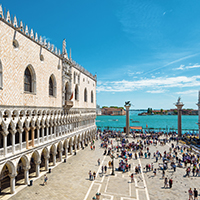Pros & Cons of Living in Milan
Summary: If you're considering a move to Milan, this article discusses the pros and cons of living in Milan.
Thinking about moving to Milan? Below we highlight some of the pros and cons of living in Milan.
Italy is a country that is rich in history, culture, and cuisine. One of its most vibrant cities is Milan, a global capital of fashion and design. Known for its high-end restaurants and shops, Milan is a bustling metropolis that offers a unique blend of modern sophistication and old-world charm. But like any city, living in Milan has its pros and cons. In this article, we will delve into the advantages and disadvantages of residing in this Italian city.
Pros of Living in Milan
One of the biggest advantages of living in Milan is the city's rich cultural heritage. Milan is home to some of the world's most famous art and architecture, including the iconic Duomo di Milano, a massive Gothic cathedral, and Leonardo da Vinci's The Last Supper. The city's museums, such as the Pinacoteca di Brera and the Museo del Novecento, offer a wealth of artistic treasures for residents to explore.
Another advantage of living in Milan is its vibrant fashion and design scene. As one of the world's fashion capitals, Milan is a hub for designers, models, and fashion enthusiasts. The city hosts the prestigious Milan Fashion Week twice a year, attracting fashionistas from around the globe. For those interested in design, the annual Salone del Mobile is a must-visit event that showcases the latest in furniture and design from international brands.
Food lovers will also find plenty to enjoy in Milan. The city is known for its diverse culinary scene, which ranges from traditional Italian fare to international cuisine. Milanese specialties such as risotto alla Milanese, cotoletta alla Milanese, and panettone are a must-try. The city is also home to a number of Michelin-starred restaurants, including Ristorante Cracco and Il Luogo di Aimo e Nadia.
For those who value education, Milan boasts some of Italy's top universities, including the University of Milan and the Politecnico di Milano. These institutions offer a wide range of courses in fields such as fashion, design, engineering, and the sciences. Additionally, Milan's international schools provide excellent education options for expat families.
Lastly, Milan's location makes it an ideal base for exploring other parts of Italy and Europe. The city's efficient public transportation system, including its extensive metro and tram network, makes getting around easy. Milan's airports, Malpensa and Linate, offer flights to a variety of domestic and international destinations. And with Italy's high-speed train network, cities like Venice, Florence, and Rome are just a short ride away.
Cons of Living in Milan, Italy
Despite its many advantages, living in Milan also has its downsides. One of the biggest challenges is the high cost of living. Rent in the city center can be expensive, and dining out, shopping, and entertainment can quickly add up. While salaries in Milan are generally higher than in other parts of Italy, they may not be enough to offset the high living costs.
Another downside of living in Milan is the city's air quality. Milan is one of the most polluted cities in Europe, largely due to car emissions and industrial activity. This can lead to health problems, especially for those with respiratory conditions. The city has implemented measures to combat pollution, such as car-free Sundays and restrictions on older vehicles, but air quality remains a concern.
While Milan's public transportation system is generally efficient, it can also be crowded, especially during rush hour. Delays and strikes are not uncommon, which can make commuting a hassle. Additionally, while the city is generally safe, petty crime such as pickpocketing can be a problem, particularly in tourist areas and on public transportation.
Language can also be a barrier for those who do not speak Italian. While English is commonly spoken in tourist areas and by younger Italians, it is less commonly spoken by older generations and in less touristy areas. This can make everyday tasks such as shopping or visiting the doctor more challenging.
Finally, while Milan's location makes it easy to travel to other parts of Italy and Europe, it also means that the city can be crowded with tourists, especially during peak travel seasons. This can lead to crowded attractions, higher prices, and a less authentic experience of the city.
In conclusion, living in Milan offers a unique blend of culture, fashion, and cuisine, but it also comes with challenges such as a high cost of living and poor air quality. Ultimately, whether Milan is the right place for you will depend on your personal preferences and lifestyle.
 Italian For A While
Italian For A WhileConnect
Become ‘Italian for a While’ with IFA! Learn in Italy on a 1-week to 12-month program - open to students, young adults, graduates, digital nomads, professionals, groups, faculty-led programs, and more. Take courses at an accredited school while immersing yourself in the language, life, and culture among your international peers. Submit an inquiry with IFA to learn more.
Click connect to have our partner contact you via e-mail and/or phone.
 Italian For A While
Italian For A WhileBecome ‘Italian for a While’ with IFA! Learn in Italy on a 1-week to 12-month program - open to students, young adults, graduates, digital nomads, professionals, groups, faculty-led programs, and more. Take courses at an accredited school while immersing yourself in the language, life, and culture among your international peers. Submit an inquiry with IFA to learn more.
Connect
Click connect to have our partner contact you via e-mail and/or phone.
About the Author
 Joshua Wood, LPC joined Expat Exchange in 2000 and serves as one of its Co-Presidents. He is also one of the Founders of Digital Nomad Exchange. Prior to Expat Exchange, Joshua worked for NBC Cable (MSNBC and CNBC
Primetime). Joshua has a BA from Syracuse and a Master's in Clinical and Counseling Psychology from Fairleigh Dickinson University. Mr. Wood is also a licensed counselor and psychotherapist.
Joshua Wood, LPC joined Expat Exchange in 2000 and serves as one of its Co-Presidents. He is also one of the Founders of Digital Nomad Exchange. Prior to Expat Exchange, Joshua worked for NBC Cable (MSNBC and CNBC
Primetime). Joshua has a BA from Syracuse and a Master's in Clinical and Counseling Psychology from Fairleigh Dickinson University. Mr. Wood is also a licensed counselor and psychotherapist.
Some of Joshua's articles include Pros and Cons of Living in Portugal, 10 Best Places to Live in Ireland and Pros and Cons of Living in Uruguay. Connect with Joshua on LinkedIn.
Additional Information:
- Best Neighborhoods for Single Digital Nomads Living in Milan
- Pros & Cons of Living in Milan
- Fun Classes for Expats Living in Milan
- Best Neighborhoods for Retirees in Milan
- Best Neighborhoods for Families in Milan
- Best Neighborhoods for Single People in Milan
- Best International Schools and Bilingual Schools in Milan
- 7 Weekend Getaways for Digital Nomads Living in Milan
- Fun Classes for Expats Living in Milan
- Best Bookstores and Libraries in Milan
- Public Transportation in Milan
- Best Markets in Milan
- Retire in Milan Guide
- 7 Tips for Living in Milan
- Pros & Cons of Living in Milan
- Cost of Living in Milan
- Health Care in Milan
- The Insider's Guide to Milan
- 8 Tips For Living in Milan
- Healthcare & Health Insurance in Italy
- Best Places to Live in Italy
- Real Estate in Italy
- 15 Best Places to Live in Italy
- What It's Like Living in Milan
- Pros and Cons of Living in Italy 2025
- 2025 Guide to Moving to Italy
- More Advice about Retiring in Italy



